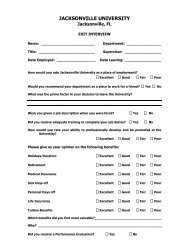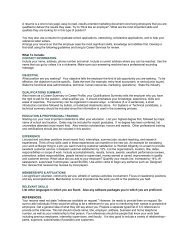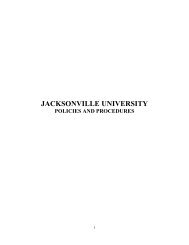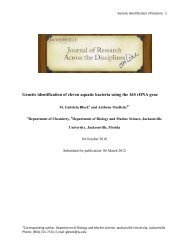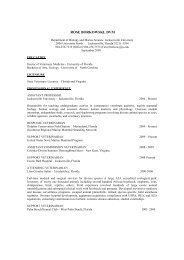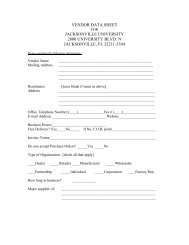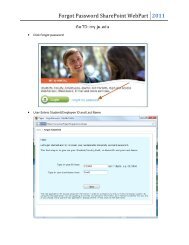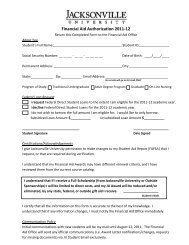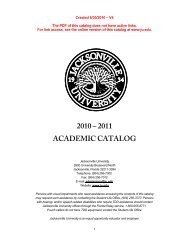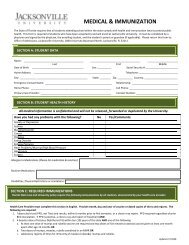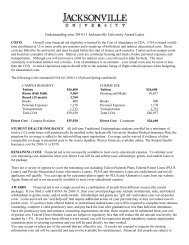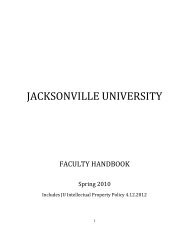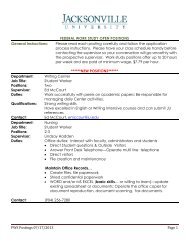Hixon 1 Concentrations and identities of fecal coliform bacteria from ...
Hixon 1 Concentrations and identities of fecal coliform bacteria from ...
Hixon 1 Concentrations and identities of fecal coliform bacteria from ...
Create successful ePaper yourself
Turn your PDF publications into a flip-book with our unique Google optimized e-Paper software.
<strong>Hixon</strong> 7<br />
Testing began with using the membrane filtration technique: triplicates <strong>of</strong> 50mL <strong>of</strong> each sample<br />
was filtered on 0.45µm filters <strong>and</strong> then placed onto M-FC agar (Fisher Scientific Catalog<br />
Number DF0677173), which is selectable for <strong>fecal</strong> <strong>coliform</strong> <strong>bacteria</strong>l growth, in 50x9mm Petri<br />
dishes. The incubation period for the 1/29/11 collection was 24 hours <strong>and</strong> 37 minutes <strong>and</strong> 18<br />
hours <strong>and</strong> 35 minutes for 3/12/11 collection at 46 ºC. Fecal <strong>coliform</strong> CFUs were visually counted<br />
using a Leica Quebec Darkfield Colony Counter <strong>and</strong> these numbers were multiplied by two to<br />
calculate <strong>fecal</strong> <strong>coliform</strong> CFUs per 100mL (table 1). Only blue colonies were counted, all brown<br />
or <strong>of</strong>f white colonies were considered not to be <strong>fecal</strong> <strong>coliform</strong> <strong>bacteria</strong> CFUs. Water pH was<br />
measured using a Corning pH meter 125, which was calibrated prior to use. To calculate total<br />
<strong>bacteria</strong>l counts, triplicates <strong>of</strong> serial dilutions using 0.85% NaCl in 100mL dilution containers<br />
were completed in tenfold increments <strong>from</strong> tenfold to one-thous<strong>and</strong> fold, followed by plating a<br />
0.1mL sample onto TSA <strong>and</strong> incubating for 42 hours <strong>and</strong> 5 minutes at 37 ºC prior to counting.<br />
IDENTIFICATION OF FECAL COLIFORM BACTERIA<br />
Morphological, physiological, <strong>and</strong> metabolic tests were used to identify <strong>and</strong> differentiate<br />
<strong>fecal</strong> <strong>coliform</strong> <strong>bacteria</strong> <strong>from</strong> each <strong>of</strong> the sampling locations. Three r<strong>and</strong>om <strong>and</strong> separate <strong>fecal</strong><br />
<strong>coliform</strong> <strong>bacteria</strong> colonies, one <strong>from</strong> each <strong>of</strong> the three triplicate plates per sample site (totaling 18<br />
isolates), were chosen <strong>and</strong> successively quadrant streaked six times on m-endo agar (Fisher<br />
Scientific Catalog Number DF0677173), in order to promote only <strong>fecal</strong> <strong>coliform</strong> <strong>bacteria</strong> growth.<br />
Single colonies were used for testing <strong>and</strong> each sample was quadrant streaked on a new m-endo<br />
plate weekly in order to have living <strong>bacteria</strong> available for all tests. Before individual <strong>fecal</strong><br />
<strong>coliform</strong> <strong>bacteria</strong> testing for differentiation among <strong>fecal</strong> <strong>coliform</strong> <strong>bacteria</strong> began, m-endo slants<br />
were streaked, incubated for 11 hours <strong>and</strong> 20 minutes, sealed tight, <strong>and</strong> store in a refrigerator<br />
with a temperature ranging <strong>from</strong> 0 to 5ºC for preservation. The methods for identification were



